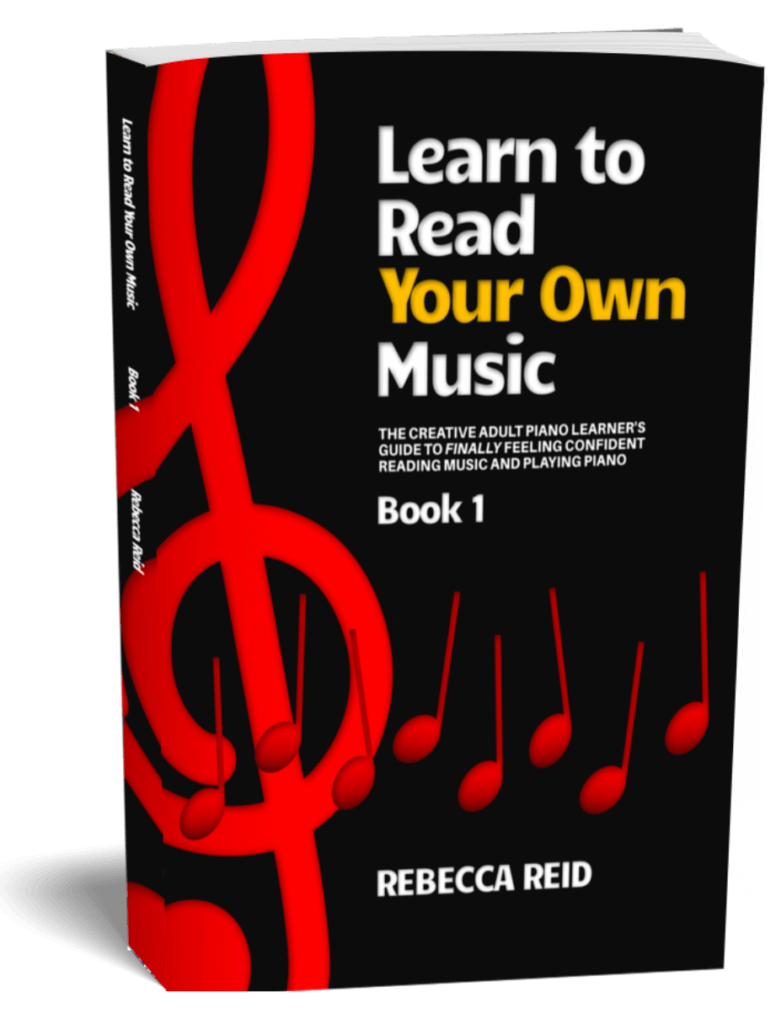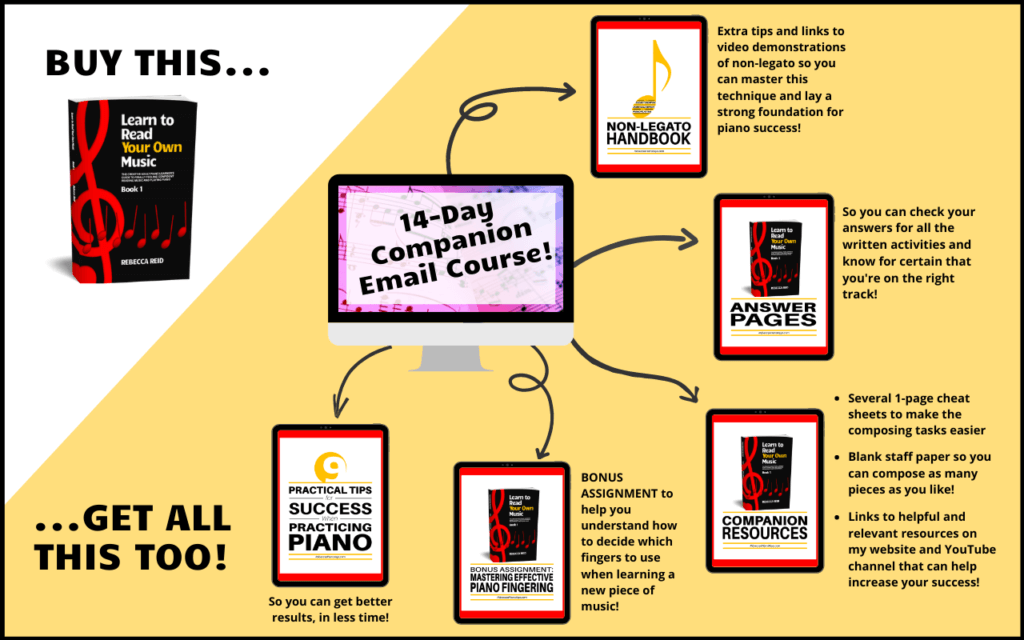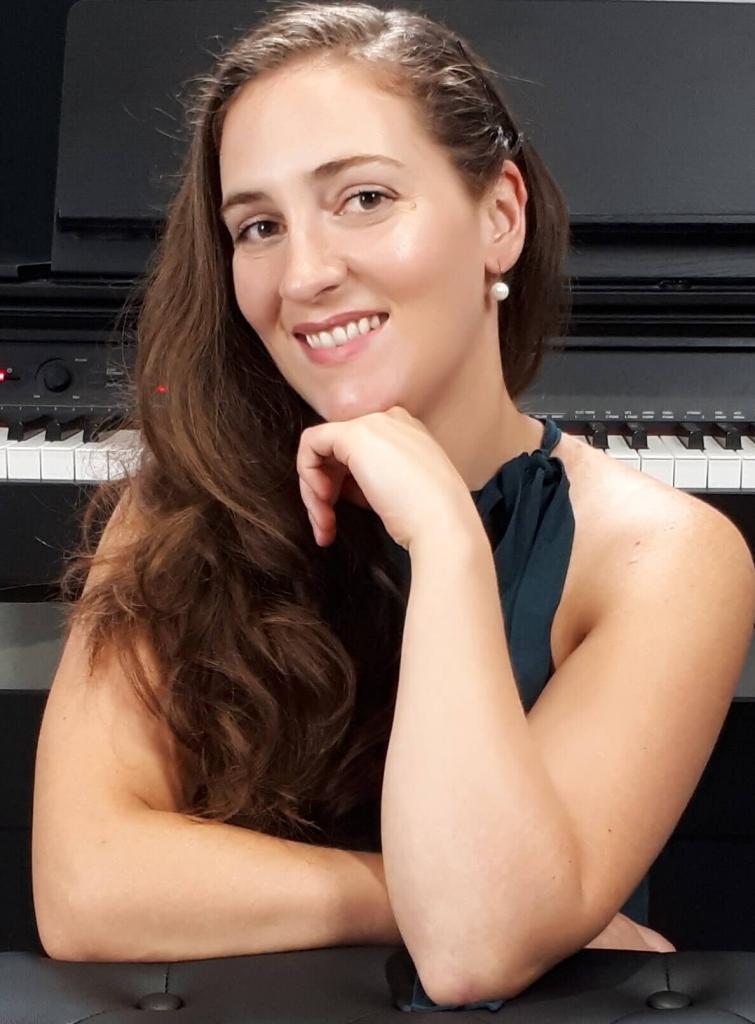Tired of struggling to learn how to read music?
Learn to Read Your Own Music Book 1 is the creative adult piano learner's guide to finally feeling confident reading music and playing piano!

Do you feel…
Unfortunately, when it comes to learning piano, a lot of conventional attitudes, beliefs, and resources actually set you up to continue struggling with these problems no matter how much you practice!
“I did it! I actually did it! I am playing multiple measures of music fluidly without having to look up keys or notes. Sometimes without even having to look down!! I am beyond proud of myself.”
– Nicole, from Mesa, Arizona, USA –
Which of these piano myths have been holding you back?
When it comes to learning piano, there are 4 big myths that a lot of people seem to believe. So let's just set the record straight!
The Learn to Read Your Own Music series is different because it focuses on using composition exercises to help you reinforce your learning and practice playing piano.
In addition to clear and easy to understand lessons and diagrams, it also includes a series of written activities, practice pieces, and composition exercises. And it's all organized into a logical, easy-to-follow progression so you never have to feel stuck or overwhelmed.
“It’s a comprehensive teach yourself book to get you started playing the piano and composing. It is written in an informal style which is straightforward and easy to follow. Great for beginners.”
– Katherine Knock, from England, UK –
So what will you find inside Learn to Read Your Own Music Book 1?
In Book 1, you'll become familiar with the entire grand staff, simply by mastering: 1 essential (and often overlooked) technique, 8 simple rhythms, 3 special notes, and 3 small intervals.
And it's all structured in a logical progression to help you move forward in your learning with confidence, one step at a time.
Unit 1: The Basics
By the end of this unit, you'll understand how to play without tension so you can create the best possible sound without experiencing any aches and pains, you'll lbe able to quickly and easily locate any key on the piano, you'll be able to read finger numbers, and you'll finally understand how the lines and spaces of the music staff relate to the keys on your piano.
Unit 2: Rhythm
By the end of this unit, you'll know how to read time signatures, you'll be able to read and write the 4 most basic note values, you'll understand how meter gives each time signature its own heartbeat, and you'll have selected your favourite of 4 different strategies for counting rhythms.
With your new confidence reading rhythms, you'll be ready to start learning to read pitches!
Unit 3: Your First 3 Guide Notes!
By the end of this unit, you'll understand how ledger lines work, you'll be able to draw the treble and bass clefs, and you'll understand how to use these clefs as “cheats” to help you read music more easily, and you'll be able to play music using fingers 2, 3, and 4 (yes, your 4th finger will finally be starting to cooperate!).
Most importantly, you'll feel confident reading and playing music using your first 3 guide notes: middle C, treble G, and bass F.
Unit 4: Direction and Intervals
By the end of this unit, you'll feel confident using direction and intervals to play music that explores the full range of the grand staff. You'll also learn to play music thoughtfully and with expression (so you don't sound like a robot), and you'll also be able to play with the 2 shortest fingers of your hands: the pinky and the thumb.
Nothing in this book is a big secret. In fact, you could learn all of this information for free from Google or YouTube. I even have free resources on my own website and YouTube channel that will help you with some of this learning.
But Learn to Your Own Music Book 1 is about more than just sharing information… it's about helping you gain confidence. It's designed to help you apply your new learning in practice so you can improve your confidence reading music and playing piano.
“It helped me a lot and taught me things in more detail than other books I’ve used.”
– Billie, from North Carolina, USA –
When you buy Learn to Read Your Own Music Book 1, you'll also be able to sign up to receive these free bonuses!

Are you ready to stop struggling and finally feel confident reading and playing music?
Learn to Read Your Own Music Book 1 is exactly the workbook you've been waiting for!
“Do yourself a favor and get this book if you would like to learn the right way.”
– Thomas McClain, from Delaware, USA –
Who am I to be teaching you this?
Hi, I'm Rebecca!
I started learning piano as a very young child, and now it brings me so much joy to share my knowledge with others!
After 10 years teaching various subjects in Ontario schools, I finally opened my own piano studio for students of all ages in my small town. But I soon realized I wanted to be able to help even more people, so I founded RebeccasPianoKeys.com.
My goal is to help creative adult piano learners all over the world experience the joy of successfully and confidently playing piano and creating music.

“As an overall sentiment, I loved the structure and pacing of the guide. It flowed well and my confidence increased from chapter to chapter as I continued to build on each new set of knowledge. Specifically speaking, I LOVED learning how to think about skips and steps. I always tried to make sure I knew what each note was before I played it, but being able to work from Treble G and Bass F, and even middle C for me, made so much sense. It made playing “fluidly” a possibility. <3″
– Nicole, from Mesa, Arizona, USA –
Learn to Read Your Own Music Book 1 is more than just a great book and a fantastic learning tool… it's a complete transformation of your piano experience!
Your life before Learn to Read Your Own Music Book 1
Your life after Learn to Read Your Own Music Book 1
“I have some knowledge but I’ve never taken lessons. It helped me to put the pieces together as in as puzzle.”
– Billie, from North Carolina, USA –